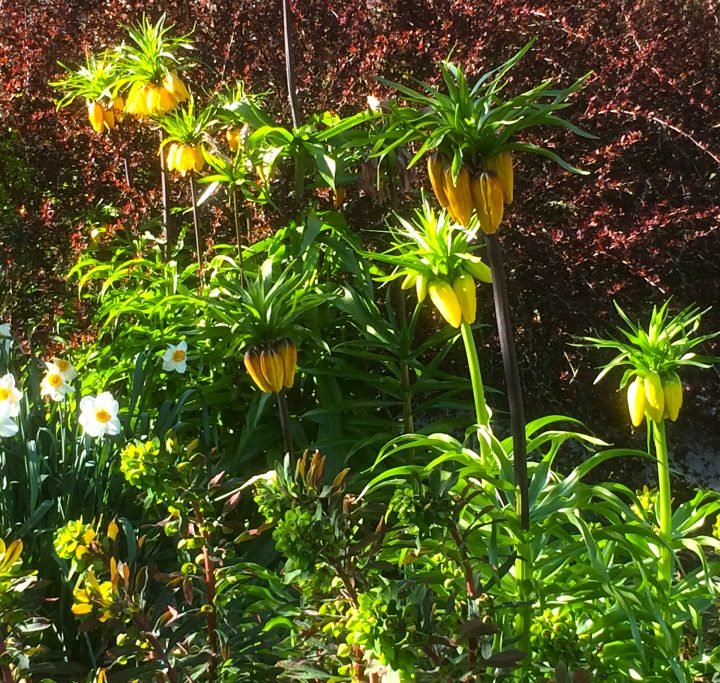
By Peg Keenleyside
There is a cycle to the gardening year: the rebirth of the early spring, the heady days of early summer flowers and shrubs, then on to the clamoring hot colors of late summer perennials, followed by the long, slow sunset of the fall garden and into the quiet of winter.
It’s the cycle of life of course, seen through the lens of that little patch of earth we tend. And one of the great joys of the dirt-digging pursuit is to plan ahead for the rebirth of the garden in spring. It’s in the sunset of this years’ fall, in fact, that much of what we plant makes that rebirth of the garden next spring such a life-affirming thing to behold.
As my late gardening friend Jody Hackleman might suggest, it all starts with bulbs. Plant them in the fall and get your visual reward when they flower in the spring.
For the uninitiated bulb planter, there is a dizzying array of choices, from low-growing tiny crocus, to funky fringed tulips, to the very cool looking 4' tall ornamental onions called alliums.
There are so many choices in fact, that I suspect most people just settle for the tried-and-true they know: yellow daffodils and a bag or two of plain Jane colored tulips found at the garden center.
To explore all the truly fabulous bulb options available however, you need to go online to a reputable website like johnscheepers.com and mail order a selection to yourself.
The time for getting a bulb order in to a supplier is September for October planting.
But how do you select from the seemingly endless types of bulbs available online?
First up is having a good look through the sections on the site to choose some bulb types. My go-to list includes crocus, narcissi (daffodils are in this group), Dutch iris, a couple of varieties of tulips, something from the fabulous fritillaria group of bulbs and some alliums.
Then as I peruse the options, my three main selection criteria are bloom time, flower height and wow factor. I want bulbs that will bloom in all three periods of the spring: early, mid and late. So, for example, I love the huge lavender-blue flower globes of Allium ‘Globemaster” that can have a circumference of 10 or more inches. They have a big time wow factor and bloom in April or May.
For an early spring arrival, and a bulb that scores high on my wow factor scale, try Fritillaries imperialis “Maxima Lutea” with its crown of bright green foliage and dangling yellow flower clusters on a tall stalk (pictured below).
Never mind that these big peculiar smelling bulbs are pricey, they will come back year after year. I like them planted in large pots surrounded by some mini-daffodils. The daffs will bloom in late March, the fritillaria pushing up through them in April for a fine show.
If you like cut flowers indoors in spring when it’s still too cold to hang out in the garden for very long, Dutch iris are a great choice. There are many different shades of purple and blues to choose from; the stronger the color, the more remarkable the contrast between the main petal colour and the yellow stripe running through it. Cluster these bulbs for a bouquet effect.
Look for daffodils that come up in early March – heralding spring’s arrival with their trumpet-shaped flowers. This bulb comes from the species group called narcissi and if you want to go beyond yellow the color choices in narcissi are truly
sensational.
Beyond my three main selection criteria, I often look for narcissi daffodil bulbs that will “naturalize,” meaning planted once, each bulb makes new bulblets and these offspring go on to bloom in successive years.
Tulips have, sadly, fallen out of favor in recent years it seems, which is odd because the spring garden wow factor goes way up when these bulbs come into flower. Bloom time choices include early, mid and late, and you can create an ongoing display by planting in groups for successive flowering through the spring. Another tip is to plant your tulips in large old garden center pots and dig a hole for the pot in the garden. When the bulbs are finished flowering, you can simple pull up the pot leaving others nearby to carry on the show.
As to tulip type, I am partial to the peony-shaped tulips with their multiple ruffled petals. “Angelique” in a soft pink is simply gorgeous.
For a more modern-edged choice, check out the range of parrot tulips with their pointy petals and striped flowers. There are also amazing dark-colored tulips in burgundies, purples and even blacks.
For planting bulbs, have a couple of bags of compost and some bone meal on hand to put into the planting holes or pots as you work. This will feed the bulbs during those weeks of winter when they are cooling in the ground.
Go on and have some fun with the cycle of life in your garden this year and plant some spring-flowering bulbs. You will be loving spring like never before.
Comments
No comments on this item Please log in to comment by clicking here